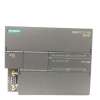Effect
If a speed value drops below a parameterized limit, a safety-related signal is generated. This can, for example, be processed in a safety controller to respond to the event by programming, depending on the situation.
Application
With the SSM function, in the simplest case, a safety door can be unlocked if the speed drops below a non-critical level. Another typical example is that of a centrifuge that may be filled only when it is operating below a configured speed limit.
Customer benefits
Unlike SLS, there is no drive-integrated fault reaction when the speed limit is exceeded. The safe feedback can be textareauated in a safety control unit, allowing the user to respond appropriately to the situation.
Activation of the Safety Integrated Functions
The STO safety function for SIMATIC MICRO-DRIVE can be activated via terminals, e.g. for use of a conventional safety circuit.
For standalone safety solutions for small to medium sized applications, it is frequently sufficient that the various sensing components are directly hardwired to the drive.
For integrated safety solutions, the safety-relevant sequences are generally processed and coordinated in the fail-safe SIMATIC controller. In this case, the system components communicate via the PROFINET fieldbus. The safety functions are controlled via the safe PROFIsafe communication protocol.
The SIMATIC MICRO-DRIVE drives can be easily integrated into the plant or system topology.
PROFIsafe (only for the failsafe variants, e.g. PDC100F)
SIMATIC MICRO-DRIVE drives support the PROFIsafe profile based on PROFINET.
PROFIsafe is an open communications standard that supports standard and safety-related communication over the same communication path (wired or wireless). A second, separate bus system is therefore not necessary. The telegrams that are sent are continually monitored to ensure safety-relevant communication.
Possible errors such as telegrams that have been lost, repeated or received in the incorrect sequence are avoided. This is done by consecutively numbering the telegrams in a safety-relevant fashion, monitoring their reception within a defined time and transferring an ID for transmitter and receiver of a telegram. A CRC (cyclic redundancy check) data security mechanism is also used.
The operating principle of Safety Integrated
Two independent switch-off signal paths
Two independent switch-off signal paths are available. All switch-off signal paths are low active. This ensures that the system is always switched to a safe state if a component fails or in the event of cable breakage. If a fault is discovered in the switch-off signal paths, the STO or SS1 function (depending on parameter settings) is activated and a system restart inhibited.
Two-channel monitoring structure
All the main hardware and software functions for Safety Integrated are implemented in two independent monitoring channels (e.g. switch-off signal paths, data management, data comparison). A cyclic crosswise comparison of the safety-relevant data in the two monitoring channels is carried out.
The monitoring functions in each monitoring channel work on the principle that a defined state must prevail before each action is carried out and a specific acknowledgement must be made after each action. If these expectations of a monitoring channel are not fulfilled, the drive coasts to a standstill (two channel) and an appropriate message is output.
Safe actual value sensing with encoder
The safe actual value sensing is based on the redundant textareauation of the differential incremental tracks A/B that supply HTL/TTL and the three Hall-effect sensors integrated in the motor.
All EC motors of the Siemens Product Partners with IQ encoder and Hall-effect sensors can be used for all of the safety functions of the SIMATIC MICRO-DRIVE.





